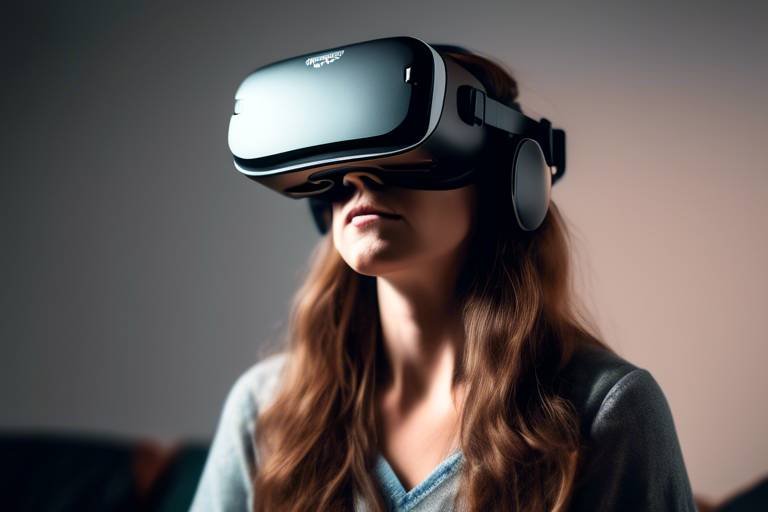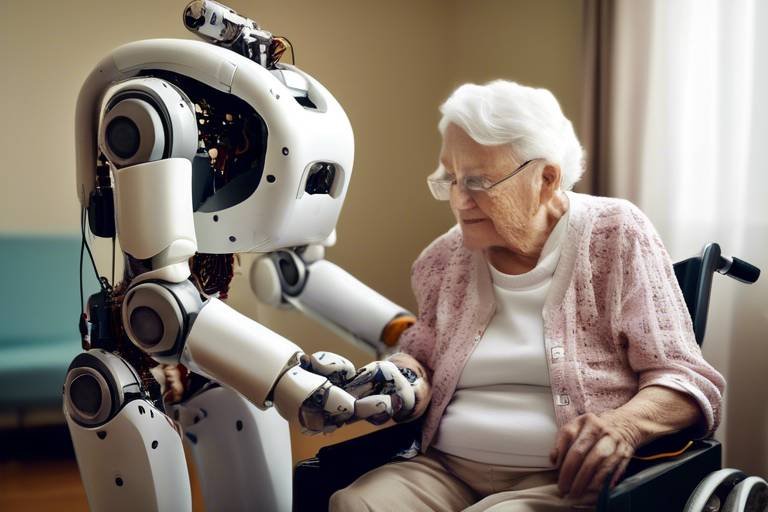How Virtual Reality is Changing Therapy Practices
Imagine stepping into a world where your fears are not just confronted, but tackled head-on in a safe and controlled environment. This is not the stuff of science fiction anymore; virtual reality (VR) is here, and it's revolutionizing therapy practices in ways we never thought possible. From treating anxiety and phobias to aiding physical rehabilitation, VR is transforming the therapeutic landscape, making treatments more immersive and effective.
The integration of VR into therapy is like adding a new dimension to traditional practices. It allows therapists to create tailored experiences that cater to individual patient needs, enhancing their engagement and motivation. In a world where mental health issues are on the rise, the demand for innovative solutions has never been greater. With VR, therapists can transport patients into scenarios that help them work through their challenges, all while providing a safe space to explore their feelings and reactions.
But what exactly does this mean for the future of therapy? Well, think of it as a bridge connecting the gap between the mind and body. VR offers a multi-sensory experience that can be both therapeutic and enjoyable. Patients can immerse themselves in environments that promote relaxation, focus, or even exposure to their fears, all while being guided by their therapist. This unique approach not only fosters a deeper connection between the therapist and patient but also opens doors to new possibilities in treatment methodologies.
As we dive deeper into the various applications of VR in therapy, it's essential to recognize the profound impact it has already made. With its ability to engage patients in ways that traditional methods often struggle to achieve, VR is not just a passing trend—it's a game changer. The future of therapy is bright, and with ongoing advancements in technology, we can only expect the potential of VR to grow.
To truly appreciate how VR has evolved therapy, we must first understand the historical context of treatment methodologies. Traditional therapy often relied heavily on verbal communication and face-to-face interactions, which, while effective, sometimes left patients feeling disconnected or disengaged. The introduction of VR technology has changed this narrative, allowing for a more interactive and engaging therapeutic experience.
In the early stages, VR was primarily used for gaming and entertainment, but as its capabilities expanded, mental health professionals began to explore its therapeutic potential. Today, we see VR being integrated into various therapeutic practices, from exposure therapy for phobias to rehabilitation for physical injuries. The evolution is not just about the technology itself; it's about how we approach healing and recovery in a holistic manner.
So, how exactly is VR being utilized across different therapeutic areas? Let’s break it down:
- Mental Health: VR is proving to be a powerful tool in treating conditions like anxiety, PTSD, and phobias.
- Physical Rehabilitation: Engaging patients in virtual environments makes rehabilitation exercises more enjoyable and effective.
- Pain Management: VR can distract patients from pain during medical procedures or chronic pain conditions.
Each application showcases the versatility of VR, allowing therapists to tailor experiences to meet the unique needs of their patients. It's like having a toolbox filled with innovative solutions that can be adapted to fit various therapeutic scenarios.
One of the most exciting applications of VR is in the treatment of anxiety and phobias. Through exposure therapy, patients can confront their fears in a controlled virtual environment, which has been shown to lead to significant improvements in anxiety management. Imagine someone with a fear of heights being able to virtually stand on the edge of a skyscraper, all while being supported by their therapist. This controlled exposure can help desensitize patients to their fears, allowing them to regain control over their emotions.
Real-life case studies have begun to emerge, showcasing the effectiveness of VR in treating specific phobias. For instance, a study involving patients with arachnophobia (fear of spiders) demonstrated that after several VR sessions, participants reported a marked decrease in their fear levels. The technology not only allowed them to face their fears but also provided a safe space for them to process their feelings. This is just one example of how VR is making a tangible difference in therapeutic outcomes.
While the immediate benefits of VR exposure therapy are impressive, it's essential to consider the long-term effects as well. Ongoing research is needed to understand how these experiences impact patients over time. Will the gains made during therapy be sustained? Are there any potential challenges that could arise from prolonged exposure to virtual environments? These are important questions that researchers are actively exploring.
In the realm of physical rehabilitation, VR is making waves by providing engaging and interactive exercises that motivate patients to push their limits. Traditional rehabilitation can often feel monotonous, leading to decreased motivation and adherence to treatment plans. However, with VR, patients can participate in fun and interactive scenarios that not only track their progress but also keep them engaged and excited about their recovery journey.
The benefits of integrating VR into therapy practices are numerous and impactful. Here are some key advantages:
- Increased Patient Engagement: VR captivates patients' attention, making therapy sessions more enjoyable.
- Enhanced Treatment Efficacy: The immersive nature of VR can lead to better treatment outcomes.
- Improved Accessibility: VR can be tailored to meet the needs of diverse populations, making therapy more accessible.
As we continue to explore the potential of VR in therapy, it's clear that the technology is not just a novelty—it's a vital tool that can enhance patient care and improve outcomes across various therapeutic settings.
While the promise of VR in therapy is exciting, it's important to acknowledge the challenges and limitations that therapists may face. Issues such as cost, accessibility, and technical limitations can hinder the widespread adoption of this innovative technology. For instance, the initial investment in VR equipment can be substantial, which may deter some practices from incorporating it into their services.
Financial and logistical barriers remain significant hurdles. Many therapists may struggle to justify the cost of VR technology, especially in settings where budgets are tight. Additionally, not all patients have access to the necessary equipment or the ability to visit facilities that offer VR therapy. Addressing these issues is crucial for the future of VR in therapeutic practices.
Another challenge lies in the technical limitations and the need for adequate training. Therapists must be well-versed in the technology to effectively implement it in their sessions. This requires ongoing training and support, which may not always be readily available. As VR technology continues to evolve, so too must the training and resources provided to therapists.
Looking ahead, the future of VR in therapy is brimming with potential. As technology advances, we can expect to see even more innovative applications that enhance therapeutic practices. Imagine a world where VR is seamlessly integrated into every therapeutic setting, making treatment more engaging, effective, and accessible than ever before.
With ongoing research and development, the possibilities are endless. As we continue to explore the intersection of technology and therapy, one thing is certain: VR is not just changing therapy practices; it's reshaping the entire landscape of mental and physical health care.
- What is virtual reality therapy? Virtual reality therapy uses immersive technology to create simulated environments for therapeutic purposes, helping patients confront fears, manage pain, or engage in rehabilitation.
- Is VR therapy effective? Yes, studies have shown that VR therapy can be effective for various conditions, including anxiety, phobias, and physical rehabilitation.
- Are there any risks associated with VR therapy? While generally safe, some patients may experience discomfort or motion sickness. It’s essential for therapists to monitor patients closely during sessions.
- How can I access VR therapy? Many clinics are beginning to offer VR therapy as part of their services. Check with local mental health or rehabilitation centers to see if they provide this option.

The Evolution of Therapy with VR
The journey of therapy has undergone a remarkable transformation over the years, especially with the advent of virtual reality (VR). Traditionally, therapeutic practices relied heavily on face-to-face interactions, verbal communication, and physical assessments. However, the integration of VR technology has revolutionized these methodologies, offering a dynamic and immersive experience for both therapists and patients. Imagine stepping into a world where your fears, anxieties, and physical limitations can be confronted and managed in a safe, controlled environment—this is the power of VR in therapy.
Historically, therapy has evolved from simplistic approaches to more structured frameworks. In the early days, treatments were often rudimentary, focusing on basic behavioral techniques. As our understanding of mental health and physical rehabilitation advanced, so too did our methods. The introduction of VR into this mix has been akin to adding a new color to an artist's palette. Therapists can now create customized environments that cater specifically to the needs of their patients. For instance, a patient with a fear of heights can experience a virtual skyscraper, allowing them to confront their fears without the real-world risks.
Moreover, the technology has progressed significantly over the last decade. Initially, VR was seen as a novelty, primarily used in gaming and entertainment. However, as research began to highlight its potential in therapeutic contexts, more professionals started to explore its applications. Studies have shown that VR can enhance patient engagement, making therapy sessions not just effective but also enjoyable. With the ability to simulate real-life scenarios, therapists can guide patients through various experiences, helping them to build coping strategies and resilience.
As we look back, we can identify several key milestones in the evolution of therapy with VR:
- Early Research (1990s): Initial studies began exploring the use of VR for phobia treatment.
- Commercialization (2000s): VR technology became more accessible, leading to its adoption in clinical settings.
- Integration into Therapy (2010s): Therapists began using VR for a variety of conditions, including PTSD and anxiety disorders.
- Current Trends (2020s): Continued advancements in VR technology are leading to innovative therapeutic applications.
This evolution is not just about technology; it’s about reshaping the therapeutic landscape. The incorporation of VR has opened doors to new possibilities, allowing for a more personalized approach to treatment. Patients can engage in a variety of scenarios tailored to their specific challenges, whether it's practicing social skills in a virtual café or managing pain through immersive relaxation environments. The question now is, how far can we take this technology, and what does the future hold for therapy?
In conclusion, the evolution of therapy with VR is a testament to our ability to adapt and innovate in the face of challenges. As we continue to explore the integration of VR into therapeutic practices, we are likely to witness even more groundbreaking developments that will enhance patient care and outcomes.

Applications of VR in Different Therapeutic Areas
Virtual Reality (VR) is not just a futuristic concept; it's a groundbreaking tool that's actively reshaping the landscape of therapy across various fields. Imagine stepping into a world where your fears can be confronted with the click of a button or where rehabilitation exercises feel like a game rather than a chore. VR is making these scenarios a reality, and its applications are as diverse as they are impactful.
One of the most significant areas where VR is making waves is in mental health. Traditional therapy methods often involve talking through issues, which can sometimes feel daunting or unengaging for patients. With VR, therapists can create immersive environments that allow patients to experience exposure therapy in a controlled setting. For instance, someone with a fear of heights can 'climb' a virtual mountain, gradually facing their fears while feeling safe. This innovative approach not only enhances the therapeutic experience but also promotes faster recovery and coping strategies.
In addition to mental health, VR is revolutionizing physical rehabilitation. Patients recovering from injuries often struggle with motivation during their rehab exercises. By incorporating VR, therapists can design interactive and engaging exercises that feel less like work and more like play. Imagine a patient recovering from a knee injury who can participate in a virtual soccer game, where each kick and sprint helps them regain strength and mobility. This gamified approach not only motivates patients but also allows therapists to track progress in real-time, making adjustments as needed.
Moreover, VR is proving to be effective in pain management. Studies have shown that immersing patients in soothing virtual environments can significantly reduce their perception of pain. For example, burn victims undergoing wound care can be placed in a tranquil beach setting, allowing them to focus on the serene visuals and sounds rather than the discomfort of their treatment. This technique has shown promising results in reducing anxiety and improving overall patient satisfaction during painful procedures.
As we explore the applications of VR in therapy, it’s essential to recognize its versatility across different therapeutic areas. Below is a table summarizing the key applications of VR in therapy:
| Therapeutic Area | Application |
|---|---|
| Mental Health | Exposure therapy for phobias and anxiety disorders |
| Physical Rehabilitation | Interactive exercises for injury recovery |
| Pain Management | Immersive environments to reduce pain perception |
| Autism Spectrum Disorder | Social skills training through simulated interactions |
| Post-Traumatic Stress Disorder (PTSD) | Controlled exposure to trauma-related stimuli |
In conclusion, the applications of VR in therapy are not just limited to one area; they span a wide range of therapeutic practices, each with its unique benefits and potential for improvement. As we continue to embrace technology in our daily lives, the integration of VR into therapeutic practices is likely to grow, offering more personalized and effective treatment options for patients. It's an exciting time for both therapists and patients as we navigate this new frontier in healthcare.
Q1: How does VR help with anxiety disorders?
A1: VR helps individuals confront their fears in a safe environment, allowing them to gradually face and manage their anxiety through exposure therapy.
Q2: Is VR therapy suitable for all age groups?
A2: Yes, VR therapy can be tailored to suit different age groups, making it beneficial for children, adults, and the elderly alike.
Q3: Are there any side effects associated with VR therapy?
A3: While VR is generally safe, some individuals may experience motion sickness or discomfort. It's essential for therapists to monitor patients and provide guidance during sessions.
Q4: How can therapists measure the effectiveness of VR therapy?
A4: Therapists can use various metrics, such as patient feedback, progress tracking, and clinical assessments, to evaluate the effectiveness of VR therapy.

VR for Anxiety and Phobias
Virtual reality (VR) is transforming the way we approach mental health, particularly in treating anxiety and phobias. Imagine stepping into a world where your fears are simulated, yet you feel completely safe. This is the essence of VR exposure therapy, a groundbreaking method that allows patients to confront their fears in a controlled environment. By immersing individuals in realistic scenarios, VR helps them gradually face and overcome their anxieties, leading to significant improvements in their mental well-being.
One of the most compelling aspects of VR therapy is its ability to create a safe space for patients to experience their fears without the real-world consequences. For instance, someone with a fear of heights can virtually ascend a skyscraper, feeling the rush of adrenaline while knowing they are in a secure setting. This method not only desensitizes individuals to their fears but also equips them with coping strategies to manage anxiety in real life. The immersive nature of VR makes the experience more engaging and impactful compared to traditional therapeutic techniques.
Research has shown that VR exposure therapy can lead to remarkable outcomes for individuals struggling with various phobias. Here are some common phobias that have been effectively treated using VR:
- Fear of flying (aviophobia)
- Fear of spiders (arachnophobia)
- Fear of public speaking (glossophobia)
- Fear of heights (acrophobia)
In addition to exposure therapy, VR can also be used in conjunction with cognitive-behavioral therapy (CBT). This combination allows therapists to guide patients through their experiences, helping them reframe their thoughts and reactions to feared situations. The interactive nature of VR can enhance the therapeutic process, making it more dynamic and responsive to patient needs.
Numerous case studies have emerged, showcasing the effectiveness of VR in treating specific phobias. For instance, a study involving individuals with a fear of flying demonstrated that after several sessions of VR exposure therapy, participants reported a significant reduction in anxiety levels associated with flying. They were not only able to board a plane but also enjoyed the experience, which was a monumental step for many.
Another compelling case involved patients with social anxiety disorder. By using VR to simulate social situations, therapists could help individuals practice their social skills in a risk-free environment. Over time, patients gained confidence and reported feeling less anxious during real-life interactions. These case studies highlight the potential of VR to foster positive therapeutic outcomes, illustrating that it is not just a trend but a viable treatment option.
While the immediate benefits of VR exposure therapy are evident, the long-term effects are equally promising. Patients who undergo VR therapy often experience lasting reductions in anxiety and phobia symptoms. However, it is essential to recognize that ongoing research is necessary to fully understand the longevity of these effects. Support systems and follow-up sessions may be required to ensure sustained progress and address any potential relapses.
In conclusion, VR is revolutionizing the treatment of anxiety and phobias, providing innovative solutions that empower patients to confront their fears. As technology continues to evolve, the integration of VR into therapeutic practices will likely expand, offering even more opportunities for individuals to reclaim their lives from the grips of anxiety.
Q: How does VR exposure therapy work?
A: VR exposure therapy immerses patients in simulated environments where they can confront their fears in a safe and controlled manner. This gradual exposure helps reduce anxiety over time.
Q: Is VR therapy effective for all types of phobias?
A: While VR therapy has shown effectiveness for many common phobias, individual results may vary. It is essential to consult with a qualified therapist to determine the best approach for each specific case.
Q: Are there any side effects of VR therapy?
A: Some individuals may experience mild discomfort or nausea during VR sessions. However, these effects are generally temporary and can be managed with proper guidance from a therapist.
Q: How long does VR therapy typically last?
A: The duration of VR therapy varies based on individual needs and treatment goals. Sessions can last anywhere from a few weeks to several months, depending on the severity of the phobia and the patient's progress.

Case Studies on Phobia Treatment
When it comes to tackling phobias, traditional therapy methods often involve gradual exposure to the feared object or situation. However, the introduction of Virtual Reality (VR) has taken this approach to a whole new level. Let’s dive into some compelling case studies that showcase the effectiveness of VR in treating various phobias.
One notable case involved a patient named Sarah, who had a debilitating fear of flying. For years, this phobia restricted her travel opportunities and caused immense anxiety. In a controlled VR environment, therapists created a simulation of an airplane takeoff. Sarah was guided through the experience, starting with simply sitting in a virtual plane on the ground. Over several sessions, she progressed to experiencing takeoff, turbulence, and even landing. The immersive nature of VR allowed her to confront her fears without the immediate stress of real-world flying. Remarkably, after just a few sessions, Sarah reported a significant reduction in her anxiety levels, leading her to book a real flight for the first time in years.
Another intriguing case involved a young man named Jake, who suffered from a severe fear of spiders (arachnophobia). In Jake's case, the VR therapy began with a virtual environment that included a safe space where he could observe realistic spiders from a distance. As he became more comfortable, the sessions gradually introduced more interactive elements, allowing Jake to engage with the virtual spiders in a controlled manner. The process was not just about exposure; it included relaxation techniques and cognitive behavioral strategies to help Jake manage his anxiety. By the end of the treatment, Jake was able to hold a real spider in his hand, an achievement he once thought impossible.
These case studies highlight a few key benefits of using VR in phobia treatment:
- Controlled Environment: Patients can face their fears in a safe setting, reducing the risk of panic attacks.
- Gradual Exposure: Therapists can tailor the intensity of the exposure based on the patient’s comfort level, allowing for a personalized approach.
- Enhanced Engagement: The immersive nature of VR captivates patients, making them more willing to participate in their therapy.
While these success stories are promising, it’s essential to recognize that VR therapy isn't a one-size-fits-all solution. Each patient's journey is unique, and ongoing support from mental health professionals is crucial. As we continue to explore the potential of VR in therapeutic settings, it becomes increasingly evident that the technology offers a powerful tool for transforming lives and overcoming fears.
Q: How does VR therapy work for phobias?
A: VR therapy allows patients to confront their fears in a controlled, safe environment. Through gradual exposure and immersive experiences, patients can learn to manage their anxiety and reduce their phobic responses.
Q: Is VR therapy safe?
A: Yes, when conducted by trained professionals, VR therapy is considered safe. The controlled environment minimizes the risk of panic attacks and allows for immediate support if needed.
Q: How long does VR therapy typically take?
A: The duration of VR therapy varies by individual and the severity of the phobia. Some patients may see significant improvements in just a few sessions, while others may require more extended treatment.
Q: Can VR therapy be used for other conditions besides phobias?
A: Absolutely! VR therapy is also being used for anxiety disorders, PTSD, and even physical rehabilitation, showcasing its versatility in various therapeutic areas.

Long-Term Effects of VR Exposure Therapy
The long-term effects of Virtual Reality (VR) exposure therapy are an exciting area of research that continues to unfold as more therapists and patients embrace this innovative treatment method. One of the most significant benefits of VR exposure therapy is its ability to create a safe and controlled environment where patients can confront their fears. This method not only helps in reducing anxiety in the short term but also fosters lasting changes in how individuals respond to their fears over time.
Studies have shown that patients who undergo VR exposure therapy often experience a significant reduction in the intensity and frequency of their anxiety responses. For instance, a patient with a fear of heights may initially feel overwhelmed when exposed to virtual high places. However, after several sessions, many report a noticeable decrease in their anxiety levels when faced with similar real-life situations. This desensitization process can lead to long-term improvements in quality of life, allowing individuals to engage in activities they once avoided.
Moreover, the immersive nature of VR allows for repeated exposure to fears in a way that traditional therapy cannot easily replicate. The ability to control various aspects of the virtual environment means that therapists can gradually increase the intensity of the exposure, tailoring the experience to the patient’s needs. This personalized approach can enhance the effectiveness of treatment, leading to more profound and enduring results.
However, while the benefits are promising, it’s essential to acknowledge potential challenges associated with long-term VR exposure therapy. For example, some patients may initially experience discomfort or even a sense of disorientation within the VR environment. These sensations can affect their willingness to engage fully in therapy sessions. Therefore, ongoing support and gradual acclimatization to the technology are crucial for ensuring a positive therapeutic experience.
In addition, researchers are investigating the potential for VR exposure therapy to be combined with other therapeutic modalities, such as cognitive-behavioral therapy (CBT). The integration of these methods may enhance the long-term effects of treatment by addressing not only the symptoms but also the underlying thought patterns contributing to anxiety. This comprehensive approach could lead to more sustainable outcomes for patients.
As we look to the future, it’s clear that the long-term effects of VR exposure therapy hold great promise. With continued advancements in technology and a growing body of research supporting its efficacy, we can expect to see VR becoming a more integral part of therapeutic practices. The potential to transform lives by helping individuals overcome their fears and anxieties is a testament to the power of innovation in mental health treatment.
- What is VR exposure therapy? - VR exposure therapy is a treatment method that uses virtual reality technology to help patients confront and manage their fears in a controlled environment.
- How effective is VR exposure therapy? - Many studies have shown that VR exposure therapy can significantly reduce anxiety and improve coping mechanisms for individuals with specific phobias and anxiety disorders.
- Are there any side effects of VR exposure therapy? - Some patients may experience discomfort or disorientation during VR sessions, but these effects are typically temporary and can be managed with appropriate support.
- Can VR exposure therapy be used alongside other therapies? - Yes, VR exposure therapy can be effectively integrated with other therapeutic approaches, such as cognitive-behavioral therapy, to enhance treatment outcomes.

VR in Physical Rehabilitation
Virtual Reality (VR) is not just a tool for gaming; it's making waves in the field of physical rehabilitation, transforming the way patients recover from injuries and surgeries. Imagine a world where rehabilitation is not just about repetitive exercises but involves immersive experiences that make the process engaging and enjoyable. This is the reality that VR brings to the table. By creating a simulated environment, VR allows patients to perform therapeutic exercises in a way that feels less like a chore and more like an adventure.
One of the most significant advantages of using VR in physical rehabilitation is its ability to provide real-time feedback. Patients can see their movements projected in a virtual space, allowing them to adjust their techniques instantly. This immediate feedback loop helps in fine-tuning their motor skills and enhances their understanding of their physical limits. Additionally, VR can track progress over time, offering both patients and therapists valuable insights into rehabilitation effectiveness.
Moreover, VR can be tailored to individual needs, catering to various levels of ability. For instance, a patient recovering from a stroke might engage in virtual exercises that focus on regaining mobility, while another recovering from a sports injury might work on strength training in a virtual gym setting. This customization is crucial, as it ensures that patients are not only challenged but also motivated to continue their recovery journey.
To illustrate the effectiveness of VR in physical rehabilitation, consider the following table that showcases some common VR applications in this field:
| Application | Description | Benefits |
|---|---|---|
| Balance Training | Simulated environments where patients practice maintaining balance. | Improves stability and reduces fall risk. |
| Strength Training | Interactive games that require physical movements to progress. | Increases muscle strength in a fun way. |
| Motor Skill Development | Tasks that involve reaching, grasping, and coordination. | Enhances fine motor skills and dexterity. |
Another key aspect of VR in rehabilitation is its ability to promote social interaction. Many VR platforms allow for multi-user experiences, enabling patients to engage in group therapy sessions or compete against others in rehabilitation exercises. This social element can significantly boost motivation and adherence to treatment plans, making the recovery process feel less isolating.
However, while the benefits are substantial, it's essential to recognize that VR is not a one-size-fits-all solution. Each patient's needs and preferences must be considered to ensure the best outcomes. As technology advances, the integration of VR into rehabilitation practices will likely continue to evolve, offering even more innovative ways to support patient recovery.
In conclusion, the integration of VR into physical rehabilitation is a game-changer. By making therapy more interactive, engaging, and tailored to individual needs, VR has the potential to revolutionize how we approach recovery. As we look to the future, the possibilities for VR in therapy are endless, paving the way for more effective and enjoyable rehabilitation experiences.
Q1: How does VR improve patient motivation during rehabilitation?
A1: VR makes rehabilitation engaging and fun, turning exercises into games that patients look forward to, which significantly boosts their motivation.
Q2: Can VR be used for all types of physical rehabilitation?
A2: While VR can be beneficial for many rehabilitation types, it’s essential to tailor the experience to individual needs and ensure it aligns with specific recovery goals.
Q3: Are there any risks associated with using VR in therapy?
A3: Generally, VR is safe, but some patients may experience motion sickness or discomfort. It’s crucial to monitor patients and adjust the experience as needed.
Q4: How do therapists measure progress when using VR?
A4: VR systems often include tracking features that record patient performance, allowing therapists to analyze data and adjust treatment plans accordingly.

Benefits of Integrating VR into Therapy
Integrating Virtual Reality (VR) into therapeutic practices is not just a trend; it’s a revolution that is reshaping how we approach mental and physical health. The benefits of VR in therapy are numerous and impactful, making it an essential tool for therapists and patients alike. First and foremost, one of the most significant advantages is the increased patient engagement. Traditional therapy can often feel monotonous or intimidating, but VR transforms the experience. Imagine stepping into a vibrant, immersive world where you can confront your fears or practice social skills without the pressure of real-world consequences. This engaging environment keeps patients motivated and invested in their treatment, leading to improved adherence to therapy plans.
Furthermore, VR allows therapists to create customized therapeutic experiences tailored to individual patient needs. For instance, a therapist can design specific scenarios to help a patient deal with anxiety or practice skills for social interactions. This level of personalization is difficult to achieve in traditional settings. Additionally, VR can facilitate exposure therapy in a controlled and safe environment, allowing patients to gradually confront their fears in a way that feels manageable and less overwhelming. This approach not only enhances the therapeutic experience but also fosters a sense of accomplishment as patients navigate through their fears.
Another remarkable benefit of VR in therapy is its ability to measure treatment outcomes effectively. With the integration of VR, therapists can utilize built-in analytics to track patient progress in real time. This data-driven approach provides valuable insights into how well a patient is responding to treatment. For example, a therapist can monitor a patient's heart rate, stress levels, or even their emotional responses during VR sessions, enabling them to adjust the treatment plan as needed. This level of feedback is a game-changer, allowing for more precise and effective therapeutic interventions.
Moreover, VR is breaking down barriers to accessibility. Patients who may have difficulty attending in-person sessions due to geographical constraints, mobility issues, or time limitations can benefit from VR therapy. With the right equipment, therapy can be conducted from the comfort of one’s home, making mental health support more accessible to diverse populations. This is particularly beneficial for those in remote areas or for individuals who might feel stigmatized seeking help in traditional settings.
In addition to these benefits, VR also fosters a sense of community among patients. Many VR platforms allow for group therapy sessions where individuals can interact and support each other in a virtual space. This social aspect can significantly enhance the therapeutic experience, as patients realize they are not alone in their struggles. The feeling of connection and shared experience can be incredibly powerful, promoting healing and growth.
Despite these remarkable advantages, it is essential to acknowledge that integrating VR into therapy is not without its challenges. However, the potential benefits far outweigh the hurdles, paving the way for a new era in therapeutic practices. As technology continues to advance, we can expect even more innovative applications of VR in therapy, ultimately improving patient outcomes across various therapeutic settings.
- What types of therapy can benefit from VR? VR can be used in various therapeutic areas, including anxiety management, phobia treatment, physical rehabilitation, and pain management.
- Is VR therapy safe? Yes, when conducted by trained professionals, VR therapy is considered safe and effective for many patients.
- Do I need special equipment for VR therapy? Yes, VR therapy typically requires a VR headset and compatible software, but many therapists provide access to this technology during sessions.
- How does VR improve patient engagement? VR creates immersive and interactive experiences that captivate patients' attention, making therapy more enjoyable and motivating.

Enhancing Patient Engagement
When it comes to therapy, one of the most crucial elements for success is patient engagement. Traditional methods often struggle to keep patients motivated and invested in their treatment plans. Enter Virtual Reality (VR), a game-changing technology that captivates and immerses patients in a way that conventional approaches simply can't match. Imagine stepping into a world where your therapy sessions feel less like a chore and more like an adventure. Sounds exciting, right?
VR has the unique ability to transform therapy from a passive experience into an interactive one. By using immersive environments, therapists can create scenarios that resonate with patients, making them feel more involved in their healing journey. For instance, a patient dealing with anxiety might find themselves in a calming virtual beach setting, where they can practice relaxation techniques without the pressures of the outside world. This not only enhances their experience but also encourages them to actively participate in their treatment.
Moreover, the use of VR can facilitate a deeper emotional connection between the therapist and patient. As patients engage with the virtual scenarios, they are more likely to open up about their feelings and experiences. This increased level of engagement can lead to more meaningful discussions during therapy sessions, ultimately fostering a stronger therapeutic alliance. In fact, studies have shown that patients who are actively engaged in their treatment are more likely to adhere to their plans and achieve better outcomes.
But how exactly does VR enhance patient engagement? Here are a few key factors:
- Interactive Experiences: VR allows patients to participate in their therapy actively, rather than passively receiving information.
- Personalization: Therapists can tailor VR experiences to meet individual patient needs, creating a more relevant and impactful treatment.
- Gamification: Many VR applications incorporate game-like elements, making therapy fun and motivating, which can significantly improve compliance.
Furthermore, the data collected during VR sessions can provide therapists with valuable insights into patient progress. By analyzing how patients interact with different scenarios, therapists can adjust their approaches and tailor future sessions to better meet the patient's needs. This data-driven aspect not only enhances engagement but also ensures that therapy remains effective and relevant.
In conclusion, the integration of VR into therapeutic practices is revolutionizing how we think about patient engagement. By creating immersive, interactive experiences that resonate with patients, VR not only makes therapy more enjoyable but also fosters a deeper connection between patients and therapists. As we continue to explore the potential of this technology, the future of therapy looks not just promising but also incredibly exciting.

Measuring Treatment Outcomes
In the realm of therapy, understanding how effective a treatment is can make all the difference. With the integration of Virtual Reality (VR) into therapeutic practices, measuring treatment outcomes has taken on a whole new dimension. Traditional methods of assessment often rely on subjective reports from patients or generalized scales that may not capture the full picture. However, VR offers innovative ways to quantify progress and effectiveness, providing therapists with a more objective set of data.
One of the most exciting aspects of VR in therapy is its ability to create immersive environments that can be tailored to individual patient needs. For instance, during a session, a therapist can use VR to simulate real-world scenarios relevant to the patient's treatment goals. This not only allows for a more engaging experience but also enables therapists to collect detailed metrics on patient responses and behaviors in these controlled settings.
Imagine a patient with a fear of flying. Using VR, a therapist can gradually expose the patient to various flying scenarios—from sitting in a grounded airplane to experiencing turbulence at 30,000 feet. By monitoring physiological responses such as heart rate, skin conductance, and even self-reported anxiety levels throughout these sessions, therapists can gather concrete data on progress. This data can then be analyzed to determine the effectiveness of the treatment protocol.
Moreover, the ability to track patient engagement and adherence to therapy is significantly enhanced with VR. Therapists can utilize built-in analytics to see how often patients engage with the VR exercises, how long they spend in each session, and their performance over time. This data not only helps in assessing treatment outcomes but also in refining therapeutic approaches to better suit individual needs.
To illustrate this, consider the following table that summarizes key metrics that can be measured through VR therapy:
| Metric | Description | Importance |
|---|---|---|
| Heart Rate | Monitors physiological responses during exposure | Indicates anxiety levels and stress response |
| Session Duration | Tracks how long a patient engages with VR | Reflects patient commitment and engagement |
| Performance Scores | Evaluates patient performance in VR scenarios | Measures progress and areas needing improvement |
| Self-Reported Anxiety Levels | Patient's subjective feelings before and after sessions | Provides insight into emotional changes and coping |
In addition to these metrics, VR can also facilitate the use of standardized assessment tools that can be integrated into the virtual experience. This means that patients can complete assessments in a familiar and engaging environment, potentially leading to more accurate results. For example, a patient might navigate through a virtual environment while answering questions related to their mental health, allowing for a seamless blend of assessment and treatment.
As we look to the future, the potential for VR to revolutionize how we measure treatment outcomes in therapy is immense. By leveraging the power of technology, therapists can gain deeper insights into their patients' progress and make informed decisions about treatment adjustments. This not only enhances the therapeutic process but also empowers patients by providing them with tangible evidence of their growth and development. In a world where data-driven decisions are becoming the norm, VR stands out as a powerful tool for measuring treatment outcomes effectively.
- How does VR improve the measurement of treatment outcomes?
VR allows for the collection of objective data through immersive experiences, enabling therapists to track physiological responses, engagement levels, and performance metrics. - Can VR be used for all types of therapy?
While VR is particularly effective for anxiety disorders, phobias, and physical rehabilitation, its application is expanding to various therapeutic areas. - Are there any risks associated with using VR in therapy?
Some patients may experience discomfort or motion sickness when using VR. It's essential for therapists to monitor these reactions closely and adjust the experience accordingly. - What is the future of VR in therapy?
The future looks promising, with ongoing advancements in VR technology likely to enhance therapeutic practices, making them more effective and accessible.

Challenges and Limitations of VR in Therapy
While the integration of Virtual Reality (VR) into therapy presents a plethora of exciting opportunities, it is essential to recognize the challenges and limitations that accompany this innovative approach. One major hurdle is the cost associated with acquiring and maintaining VR technology. High-quality VR equipment can be expensive, and not all therapy practices have the budget to invest in such resources. This financial barrier can restrict access for many therapists and their patients, particularly in underserved communities where mental health resources are already limited.
Moreover, the accessibility of VR technology poses another significant challenge. Not every patient is comfortable with technology, and some may even experience motion sickness or anxiety when using VR headsets. This discomfort can deter patients from engaging fully in their therapy sessions, potentially undermining the effectiveness of the treatment. Additionally, for individuals with certain physical disabilities, using VR equipment may not be feasible, thus limiting its applicability in a broader range of therapeutic contexts.
Another critical aspect to consider is the technical limitations of VR systems. Many therapists may find themselves grappling with technical issues that can disrupt the flow of therapy. These challenges can include software glitches, hardware malfunctions, or even a lack of adequate internet connectivity. Such interruptions not only frustrate therapists and patients alike but can also hinder the therapeutic process, making it essential for practices to have robust technical support in place.
Furthermore, the successful implementation of VR in therapy requires training for therapists. Many professionals may not have the necessary skills to effectively utilize VR technology in their practice. This gap in knowledge can lead to underutilization of VR tools or improper application, which can negatively impact patient outcomes. Thus, ongoing education and training programs are crucial to ensure that therapists are well-equipped to leverage VR in their therapeutic approaches.
In summary, while VR holds remarkable potential to transform therapy practices, addressing these challenges is vital for its successful integration. The cost, accessibility issues, technical limitations, and the need for adequate training are all factors that must be navigated to fully harness the benefits of this innovative technology. As the field evolves, ongoing dialogue and research will be essential to overcome these obstacles and ensure that VR can be a viable option for diverse patient populations.
- What are the main challenges of using VR in therapy? The primary challenges include cost, accessibility, technical issues, and the need for therapist training.
- Can everyone use VR technology in therapy? Not all patients may be comfortable with VR, and some may experience discomfort or have physical disabilities that limit their use of VR equipment.
- How can therapists overcome technical challenges with VR? Having access to robust technical support and ongoing training can help therapists effectively navigate technical issues.
- Is VR therapy effective for all types of patients? While VR has shown promise in various therapeutic areas, its effectiveness may vary based on individual patient needs and comfort levels with technology.

Cost and Accessibility Issues
The integration of Virtual Reality (VR) into therapy practices is undeniably exciting, but it also comes with its fair share of challenges, particularly regarding cost and accessibility. As much as we would love to see VR technology become a staple in every therapist's toolkit, the reality is that financial constraints often limit its adoption. The initial investment for VR equipment can be steep, with high-quality headsets and software costing thousands of dollars. This can pose a significant barrier for small practices or independent therapists who may not have the financial resources to invest in such technology.
Moreover, the ongoing costs associated with maintaining and updating VR systems can add up quickly. Therapists must also consider the expenses related to training staff to effectively use VR in their practice. Without proper training, the potential of VR can be underutilized, leading to subpar patient experiences and outcomes. This situation raises a crucial question: how can we make VR more accessible to those who need it the most?
Accessibility is another critical issue. Not all patients have equal access to VR technology. Factors such as geographic location, socioeconomic status, and even age can influence a patient's ability to engage with VR therapy. For instance, patients in rural areas may find it challenging to access therapists who offer VR services, while those from lower-income backgrounds might not afford the associated costs of treatment. To address these issues, we need to explore innovative solutions, including:
- Teletherapy Options: Offering VR therapy sessions remotely can help bridge the gap for patients who cannot travel to a therapist's office.
- Community Programs: Establishing programs that provide access to VR technology in community centers or hospitals can help reach underserved populations.
- Insurance Coverage: Advocating for insurance providers to include VR therapy in their coverage plans can alleviate some financial burdens for patients.
In addition to these solutions, collaboration between technology developers and healthcare providers is essential. By working together, they can create cost-effective VR solutions tailored to the needs of therapists and their patients. For instance, developing subscription-based models or affordable hardware options could make VR more accessible to a broader audience.
Ultimately, tackling the cost and accessibility issues surrounding VR in therapy requires a multifaceted approach. By addressing these challenges head-on, we can pave the way for a future where virtual reality is not just a novelty but a standard practice in therapeutic settings, enriching the lives of countless individuals seeking help.
1. What are the main costs associated with implementing VR in therapy?
The primary costs include purchasing VR equipment, software licenses, ongoing maintenance, and training for therapists.
2. How can VR therapy be made more accessible?
Accessibility can be improved through teletherapy options, community programs, and advocating for insurance coverage.
3. Are there any risks associated with VR therapy?
While generally safe, some patients may experience motion sickness or discomfort. It's essential for therapists to monitor their patients closely.
4. Can VR therapy be used for all types of patients?
VR therapy can be beneficial for many patients, but it's crucial to assess individual needs and potential contraindications before implementation.

Technical Limitations and Training Needs
The integration of Virtual Reality (VR) into therapy practices is undoubtedly exciting, but it doesn't come without its challenges. One of the primary hurdles is the technical limitations that can hinder both therapists and patients from fully benefiting from this innovative technology. For instance, the hardware requirements for VR can be quite demanding. High-quality VR headsets and accompanying equipment can be expensive, and not all therapy centers can afford to invest in these tools. This creates a disparity in access, as some practitioners may be unable to utilize VR even if they recognize its potential.
Moreover, the software used in VR therapy must be regularly updated and maintained to ensure a smooth user experience. Outdated software can lead to bugs or crashes during sessions, which can be frustrating for both therapists and patients. This technological unpredictability can undermine trust in VR as a legitimate therapeutic tool. Additionally, the need for a robust internet connection is often overlooked; without it, the immersive experiences that VR promises can fall flat.
Another significant challenge is the training needs for therapists. While many professionals are eager to embrace new technologies, they may feel overwhelmed by the technical skills required to operate VR systems effectively. It's not just about putting on a headset; therapists must understand how to navigate the software, tailor experiences to individual patient needs, and troubleshoot any issues that arise during sessions. This necessitates ongoing training and support, which can be resource-intensive.
To address these challenges, therapy centers should consider implementing comprehensive training programs that focus on both the technical aspects of VR and its therapeutic applications. Such programs could include:
- Workshops led by VR experts to familiarize therapists with the technology.
- Online tutorials and resources that can be accessed at any time.
- Peer support groups where therapists can share experiences and solutions.
Furthermore, partnerships with VR companies could facilitate access to cutting-edge technology and training resources. By working together, therapists and technology providers can create tailored solutions that meet the specific needs of therapeutic practices. This collaborative approach not only enhances the therapist's skill set but also ensures that patients receive the highest quality of care.
In conclusion, while the technical limitations and training needs associated with VR therapy present challenges, they are not insurmountable. By investing in training and fostering partnerships, therapists can unlock the full potential of VR, leading to more effective and engaging treatment options for their patients.
- What are the main technical challenges of using VR in therapy? The main challenges include high hardware costs, software maintenance, and the need for reliable internet connections.
- Do therapists require special training to use VR? Yes, therapists need training to effectively navigate VR systems and tailor experiences for patients.
- How can therapy centers overcome the cost barrier of VR technology? Therapy centers can explore partnerships with VR companies and seek grants or funding opportunities to offset costs.
- Are there resources available for therapists to learn about VR? Yes, many workshops, online tutorials, and peer support groups exist to help therapists gain the necessary skills.

The Future of VR in Therapy
The future of Virtual Reality (VR) in therapy is not just a distant dream; it’s unfolding right before our eyes. As technology continues to advance at a breakneck speed, we can only imagine the possibilities that lie ahead for therapeutic practices. VR has already begun to redefine how we approach mental health, physical rehabilitation, and pain management, but what comes next? The potential for enhanced patient outcomes and innovative treatment modalities is truly exciting.
One of the most promising aspects of VR's future in therapy is the integration of artificial intelligence (AI) and machine learning. These technologies can personalize therapy experiences, adapting scenarios based on individual patient responses. Imagine a patient with social anxiety who can practice social interactions in a VR environment that learns from their progress, offering increasingly challenging scenarios as they improve. This tailored approach could significantly enhance the effectiveness of exposure therapy, making it more relevant and impactful for each unique individual.
Moreover, as VR technology becomes more affordable and accessible, we may see a surge in its adoption across various healthcare settings. Teletherapy combined with VR could allow therapists to reach patients in remote areas, breaking down geographical barriers to mental health care. This could be particularly beneficial for individuals who struggle to access traditional therapy due to logistical challenges or stigma. The ability to engage in immersive therapeutic experiences from the comfort of one’s home could be a game-changer.
Additionally, the future may hold advancements in multisensory experiences. Current VR technologies primarily focus on visual and auditory stimuli, but incorporating other senses—like touch, smell, and even taste—could create a more holistic therapeutic environment. For instance, a patient undergoing rehabilitation for a traumatic injury could experience a simulated outdoor environment, complete with the sound of birds and the feel of grass underfoot, enhancing the realism and effectiveness of their therapy.
However, as we look forward, it is essential to acknowledge that the integration of VR into therapy is not without its challenges. Ethical considerations, such as ensuring patient privacy and data security, will need to be addressed as more sensitive information is collected through these technologies. Furthermore, ongoing research is needed to validate the long-term effects of VR therapy and to establish best practices for its implementation.
In conclusion, the future of VR in therapy is bright and full of potential. With continued innovation and a focus on patient-centered care, we can expect to see VR become a staple in therapeutic practices. As therapists and patients alike embrace these advancements, we stand on the brink of a new era in mental health and rehabilitation, where immersive technology can lead to profound healing and transformation.
- What is Virtual Reality therapy?
Virtual Reality therapy involves using immersive VR technology to create controlled environments for patients to confront fears, practice social skills, or engage in rehabilitation exercises.
- How effective is VR in treating anxiety and phobias?
Research shows that VR can significantly reduce anxiety and phobia symptoms by allowing patients to face their fears in a safe, controlled environment.
- Is VR therapy accessible to everyone?
While VR technology is becoming more affordable, accessibility can still be a challenge due to cost, training needs, and the availability of equipment in certain regions.
- What are the potential risks of VR therapy?
Potential risks include motion sickness, overexposure to VR environments, and privacy concerns regarding patient data.
Frequently Asked Questions
- What is Virtual Reality (VR) therapy?
Virtual Reality therapy is an innovative treatment approach that uses VR technology to create immersive environments for patients. This allows them to engage with therapeutic scenarios in a controlled setting, making it easier to confront fears, practice skills, or undergo rehabilitation exercises.
- How effective is VR in treating anxiety and phobias?
Research shows that VR can be highly effective in treating anxiety and phobias by providing exposure therapy. Patients can face their fears in a safe environment, which can lead to significant reductions in anxiety levels and improved coping strategies over time.
- Can VR be used for physical rehabilitation?
Absolutely! VR enhances physical rehabilitation by offering engaging exercises that motivate patients. These interactive sessions not only make therapy more enjoyable but also help track progress and adjust treatment plans based on real-time data.
- What are the benefits of using VR in therapy?
Some key benefits of integrating VR into therapy include increased patient engagement, improved treatment efficacy, and greater accessibility for diverse populations. Patients often find VR sessions more enjoyable, which can lead to better adherence to treatment plans.
- Are there any challenges associated with VR therapy?
Yes, there are challenges such as high costs, accessibility issues, and the need for technical training for therapists. These barriers can hinder the widespread adoption of VR technology in therapeutic settings, but ongoing advancements aim to address these concerns.
- What does the future hold for VR in therapy?
The future of VR in therapy looks promising! As technology continues to advance, we can expect more refined applications, improved accessibility, and enhanced therapeutic outcomes. This could revolutionize how therapy is delivered across various settings.



















